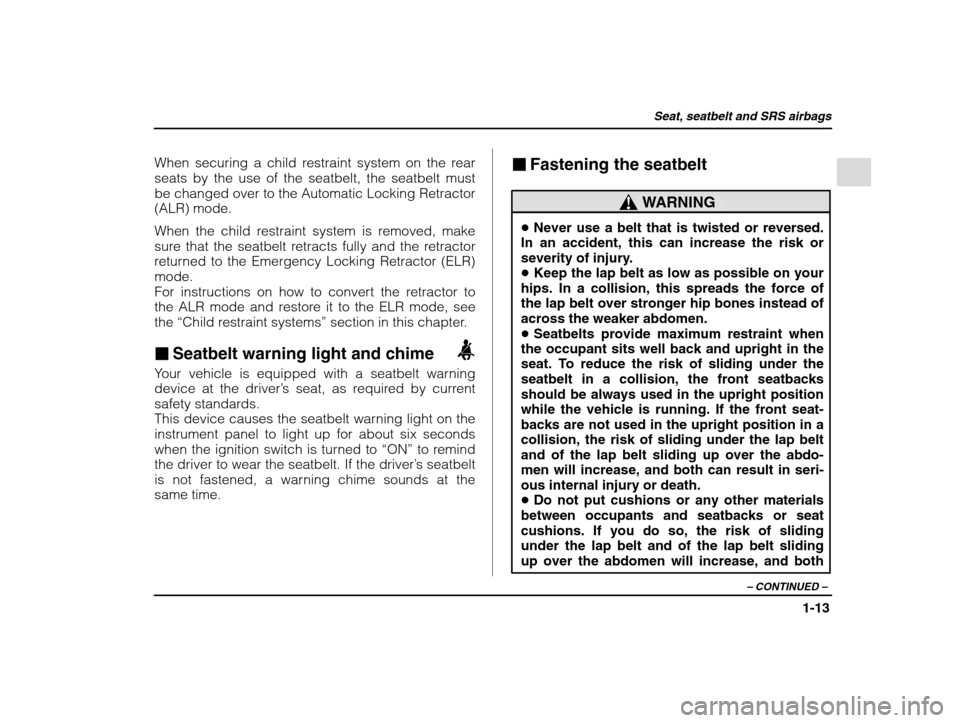2002 SUBARU IMPREZA WRX child lock
[x] Cancel search: child lockPage 8 of 390

5
– CONTINUED –
and weight. If a child is too big for a child re- straint system, the child should sit in the
REAR seat and be restrained using the seat-
belts. According to accident statistics, chil-dren are safer when properly restrained in therear seating positions than in the front seating positions. Never allow a child to stand up or
kneel on the seat.�Put children aged 12 and under in the REAR
seat properly restrained at all times in a childrestraint device or in a seatbelt. The SRS air-bag deploys with considerable speed and force and can injure or even kill children, es-
pecially if they are 12 years of age and underand are not restrained or improperly re-strained. Because children are lighter and
weaker than adults, their risk being injured
from deployment is greater. � NEVER INSTALL A REARWARD FACING
CHILD SEAT IN THE FRONT SEAT. DOING SO
RISKS SERIOUS INJURY OR DEATH TO THE
CHILD BY PLACING THE CHILD ’S HEAD TOO
CLOSE TO THE SRS AIRBAG.� Always use the child safety locks whenever
a child rides in the rear seat. Serious injurycould result if a child accidentally opened thedoor and fell out. Refer to the “Child safety locks”
section in chapter 2.
� Always lock the passenger ’s windows using
the lock switch when children are riding in the
vehicle. Failure to follow this procedure couldresult in injury to a child operating the power
window. Refer to the “Windows” section in
chapter 2.� Never leave unattended children in the ve-
hicle. They could accidentally injure them-
selves or others through inadvertent opera-tion of the vehicle. Also, on hot or sunny
days, temperature in a closed vehicle could
quickly become high enough to cause severe or possibly fatal injuries to them.� Help prevent young children from locking
themselves in the trunk. When leaving the ve-
hicle, either close all windows and lock alldoors or cancel the inside trunk lid release. Also make certain that the trunk is closed. On hot or sunny days, the temperature in a trunkcould quickly become high enough to cause
death or serious heat-related injuries includ-ing brain damage, particularly for small chil-dren.
Carefully read the sections “Child restraint systems ”,
“ SRS airbag ”, and “Seatbelts” in chapter 1 of this
Page 16 of 390

13
– CONTINUED –
HGF025BB
1) Rear window defogger switch
(page 3-24)
2) Fuel filler lid and cap (page
7-4)
3) Child safety locks (page 2-19)
4) Towing eye (page 9-15)
5) Trunk/Rear gate (page 2-23/2-27)
Page 24 of 390

1
1-1
– CONTINUED –
Front seats 1-2
. . . . . . . . . . . . . . . . . . . . . . . . . . . . . . . . . . . . . . . . . . . .
Fore and aft adjustment 1-3 . . . . . . . . . . . . . . . . . . . . . . . . . .
Reclining the seatback 1-4 . . . . . . . . . . . . . . . . . . . . . . . . . . .
Seat cushion height adjustment
(driver’ s seat) 1-5 . . . . . . . . . . . . . . . . . . . . . . . . . . . . . . . . . . . . .
Head restraint adjustment 1-5 . . . . . . . . . . . . . . . . . . . . . . .
Seat heater (if equipped) 1-6 . . . . . . . . . . . . . . . . . . . . . . . . .
Rear seats 1-7
. . . . . . . . . . . . . . . . . . . . . . . . . . . . . . . . . . . . . . . . . . . . .
Armrest (if equipped) 1-8 . . . . . . . . . . . . . . . . . . . . . . . . . . . . .
Folding down the rear seat – Wagon 1-9 . . . . . . . . . . .
Headrest adjustment (if equipped) 1-10 . . . . . . . . . . . . .
Seatbelts 1-11
. . . . . . . . . . . . . . . . . . . . . . . . . . . . . . . . . . . . . . . . . . . . . . .
Seatbelt safety tips 1-11 . . . . . . . . . . . . . . . . . . . . . . . . . . . . . . . .
Emergency Locking Retractor (ELR) 1-12 . . . . . . . . . .
Automatic/Emergency Locking Retractor (A/ELR) 1-12
. . . . . . . . . . . . . . . . . . . . . . . . . . . . . . . . . . . . . . . . . . . .
Seatbelt warning light and chime 1-13 . . . . . . . . . . . . . . .
Fastening the seatbelt 1-13 . . . . . . . . . . . . . . . . . . . . . . . . . . . .
Seatbelt maintenance 1-23 . . . . . . . . . . . . . . . . . . . . . . . . . . . . .
Front seatbelt pretensioners 1-24 . . . . . . . . . . . . . . . . . . . .
System monitors 1-25 . . . . . . . . . . . . . . . . . . . . . . . . . . . . . . . . . .
System servicing 1-26 . . . . . . . . . . . . . . . . . . . . . . . . . . . . . . . . . .
Precautions against vehicle modification 1-27 . . . . .
Child restraint systems 1-27 . . . . . . . . . . . . . . . . . . . . . . . . . . .
Installing child restraint systems with seatbelt 1-31
. . . . . . . . . . . . . . . . . . . . . . . . . . . . . . . . . . . . . . . . . . . .
Installation of child restraint systems by use of lower and tether anchorages 1-32 . . . . . . . . . Top tether anchorages 1-35
. . . . . . . . . . . . . . . . . . . . . . . . . . . .
SRS airbag
(Supplemental Restraint System airbag) 1-38 .
Vehicle with driver ’s and front passenger ’s
SRS airbags and lap/shoulder restraints 1-38 . . . .
SRS frontal airbag 1-42 . . . . . . . . . . . . . . . . . . . . . . . . . . . . . . . . .
SRS side airbag (if equipped) 1-51 . . . . . . . . . . . . . . . . . . .
SRS airbag system monitors 1-59 . . . . . . . . . . . . . . . . . . . .
SRS airbag system servicing 1-60 . . . . . . . . . . . . . . . . . . . .
Precautions against vehicle modification 1-61 . . . . .
Seat, seatbelt and SRS airbags
Page 26 of 390

Seat, seatbelt and SRS airbags
1-3
– CONTINUED –
or in a seatbelt, whichever is appropriate for
the child’s age, height and weight. Secure ALL
types of child restraint devices (including for-
ward facing child seat) in the REAR seats at alltimes.
NEVER INSTALL A REARWARD FACING CHILD
SEAT IN THE FRONT SEAT. DOING SO RISKS
SERIOUS INJURY OR DEATH TO THE CHILD
BY PLACING THE CHILD ’S HEAD TOO CLOSE
TO THE SRS AIRBAG.
According to accident statistics, children are
safer when properly restrained in the rear seat-
ing positions than in the front seating posi-
tions. For instructions and precautions con-
cerning child restraint systems, see the “Child
restraint systems ” section in this chapter. �
Fore and aft adjustment
OM-H0031
Pull the lever upward and slide the seat to the de-
sired position. Then release the lever and move the
seat back and forth to make sure that it is securely locked into place.
Page 35 of 390

Seat, seatbelt and SRS airbags
1-12
�Infants or small children
Use a child restraint system that is suitable for your
vehicle. See information on “Child restraint systems ”
in this chapter.
� Children
If a child is too big for a child restraint system, the
child should sit in the rear seat and be restrained
using the seatbelts. According to accident statistics,
children are safer when properly restrained in the
rear seating positions than in the front seating posi-tions. Never allow a child to stand up or kneel on theseat.
If the shoulder portion of the belt crosses the face or neck, move the child closer to the belt buckle to
help provide a good shoulder belt fit. Care must be
taken to securely place the lap belt as low as pos-sible on the hips and not on the child ’s waist. If the
shoulder portion of the belt cannot be properly posi-
tioned, a child restraint system should be used. Never place the shoulder belt under the child ’s arm
or behind the child ’s back.
� Expectant mothers
Expectant mothers also need to use the seatbelts.
They should consult their doctor for specific recom-
mendations. The lap belt should be worn securely and as low as possible over the hips, not over thewaist.
� Emergency Locking Retractor (ELR)
The driver ’s seatbelt has an Emergency Locking Re-
tractor (ELR).
The emergency locking retractor allows normal
body movement but the retractor locks automatically during a sudden stop, impact or if you pull the belt
very quickly out of the retractor. � Automatic/Emergency Locking Retractor (A/ELR)
Each passenger ’s seatbelt has an Automatic/Emer-
gency Locking Retractor (A/ELR). The Automatic/
Emergency Locking Retractor normally functions asan Emergency Locking Retractor (ELR). The A/ELR
has an additional locking mode “Automatic Locking
Retractor (ALR) mode ” intended to secure a child
restraint system. When the seatbelt is once drawn
out completely and is then retracted even slightly,
the retractor locks the seatbelt in that position and
the seatbelt cannot be extended. As the belt is re-
winding, clicks will be heard which indicate the re-
tractor functions as an ALR. When the seatbelt is re-
tracted fully, the ALR mode is released.
Page 36 of 390

Seat, seatbelt and SRS airbags
1-13
– CONTINUED –
When securing a child restraint system on the rear seats by the use of the seatbelt, the seatbelt mustbe changed over to the Automatic Locking Retractor(ALR) mode.
When the child restraint system is removed, make
sure that the seatbelt retracts fully and the retractor
returned to the Emergency Locking Retractor (ELR) mode.
For instructions on how to convert the retractor to
the ALR mode and restore it to the ELR mode, seethe “Child restraint systems ” section in this chapter.
� Seatbelt warning light and chime
Your vehicle is equipped with a seatbelt warningdevice at the driver ’s seat, as required by current
safety standards.
This device causes the seatbelt warning light on the
instrument panel to light up for about six seconds
when the ignition switch is turned to “ON” to remind
the driver to wear the seatbelt. If the driver ’s seatbelt
is not fastened, a warning chime sounds at thesame time. �
Fastening the seatbelt
WARNING
�Never use a belt that is twisted or reversed.
In an accident, this can increase the risk or
severity of injury. � Keep the lap belt as low as possible on your
hips. In a collision, this spreads the force of the lap belt over stronger hip bones instead ofacross the weaker abdomen.� Seatbelts provide maximum restraint when
the occupant sits well back and upright in the
seat. To reduce the risk of sliding under the
seatbelt in a collision, the front seatbacksshould be always used in the upright position
while the vehicle is running. If the front seat-
backs are not used in the upright position in a
collision, the risk of sliding under the lap belt
and of the lap belt sliding up over the abdo- men will increase, and both can result in seri-ous internal injury or death.� Do not put cushions or any other materials
between occupants and seatbacks or seat
cushions. If you do so, the risk of sliding under the lap belt and of the lap belt sliding up over the abdomen will increase, and both
Page 54 of 390

Seat, seatbelt and SRS airbags
1-31
– CONTINUED –
�Installing child restraint systems with seatbelt
HB1080BA
1. Set the child restraint system in the seating posi- tion.
2. Run the lap and shoulder belt through or around
the child restraint system following the instructions
provided by its manufacturer. If the shoulder belt
goes in front of the child ’s face or neck, put it behind
the child restraint system.
3. Insert the tongue plate into the buckle.
4. Take up the slack in the lap belt.
5. Pull out the seatbelt fully from the retractor to
change the retractor over from the Emergency Lock-ing Retractor (ELR) to the Automatic Locking Re-
tractor (ALR) function. Then, allow the belt to rewind into the retractor. As the belt is rewinding, clicks will
be heard which indicate the retractor functions asALR.
6. Before having a child sit in the child restraint sys-
tem, move it back and forth to check if it is firmly
secured. Sometimes a child restraint can be more
firmly secured by pushing it down into the seat
cushion and then tightening the seatbelt.
7. Pull at the shoulder portion of the belt to confirm
that it cannot be pulled out (ALR properly function-ing).
If the child restraint system requires a top tether,
latch the hook onto the top tether anchor and tighten
the top tether. See the
“Top tether anchorages ” for
additional instructions.
HG0188
Page 86 of 390

2
2-1
– CONTINUED –
Keys 2-2
. . . . . . . . . . . . . . . . . . . . . . . . . . . . . . . . . . . . . . . . . . . . . . . . . . . . .
Key number 2-2
. . . . . . . . . . . . . . . . . . . . . . . . . . . . . . . . . . . . . . . . .
Door locks 2-3
. . . . . . . . . . . . . . . . . . . . . . . . . . . . . . . . . . . . . . . . . . . . .
Locking and unlocking from the outside 2-3 . . . . . .
Locking and unlocking from the inside 2-4 . . . . . . .
Power door locking switches
(if equipped) 2-5 . . . . . . . . . . . . . . . . . . . . . . . . . . . . . . . . . . . . . . . .
Keyless entry system (if equipped) 2-6 . . . . . . . . . . .
Locking the doors 2-7 . . . . . . . . . . . . . . . . . . . . . . . . . . . . . . . . .
Unlocking the doors 2-7 . . . . . . . . . . . . . . . . . . . . . . . . . . . . . .
Illuminated entry 2-7 . . . . . . . . . . . . . . . . . . . . . . . . . . . . . . . . . . .
Sounding a panic alarm 2-7 . . . . . . . . . . . . . . . . . . . . . . . . . .
Selecting audible signal operation 2-8 . . . . . . . . . . . . .
Replacing the battery 2-8 . . . . . . . . . . . . . . . . . . . . . . . . . . . . .
Replacing lost transmitters 2-9 . . . . . . . . . . . . . . . . . . . . . .
Security system (if equipped) 2-12 . . . . . . . . . . . . . . . . . .
System operation 2-12 . . . . . . . . . . . . . . . . . . . . . . . . . . . . . . . . . .
Arming the system 2-13 . . . . . . . . . . . . . . . . . . . . . . . . . . . . . . . .
Disarming the system 2-15 . . . . . . . . . . . . . . . . . . . . . . . . . . . .
Sounding a panic alarm 2-15 . . . . . . . . . . . . . . . . . . . . . . . . . .
Valet mode 2-15
. . . . . . . . . . . . . . . . . . . . . . . . . . . . . . . . . . . . . . . . . .
Passive arming 2-15 . . . . . . . . . . . . . . . . . . . . . . . . . . . . . . . . . . . . .
Child safety locks 2-19 . . . . . . . . . . . . . . . . . . . . . . . . . . . . . . . . . . .
Windows 2-20
. . . . . . . . . . . . . . . . . . . . . . . . . . . . . . . . . . . . . . . . . . . . . . .
Power windows 2-20 . . . . . . . . . . . . . . . . . . . . . . . . . . . . . . . . . . . .
Trunk lid (Sedan) 2-23 . . . . . . . . . . . . . . . . . . . . . . . . . . . . . . . . . . . .
To open and close the trunk lid from outside 2-23
To open the trunk lid from inside 2-24 . . . . . . . . . . . . . . . To cancel the trunk lid release 2-24
. . . . . . . . . . . . . . . . . .
Trunk lid release handle 2-25 . . . . . . . . . . . . . . . . . . . . . . . . . .
Rear gate (Wagon) 2-27 . . . . . . . . . . . . . . . . . . . . . . . . . . . . . . . . . .
Keys and doors